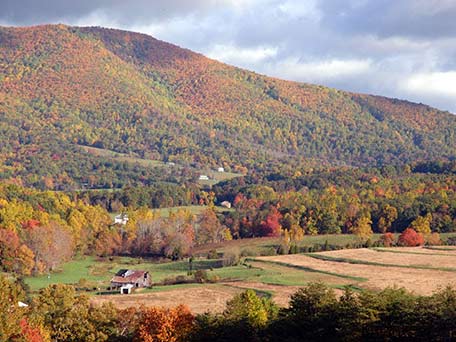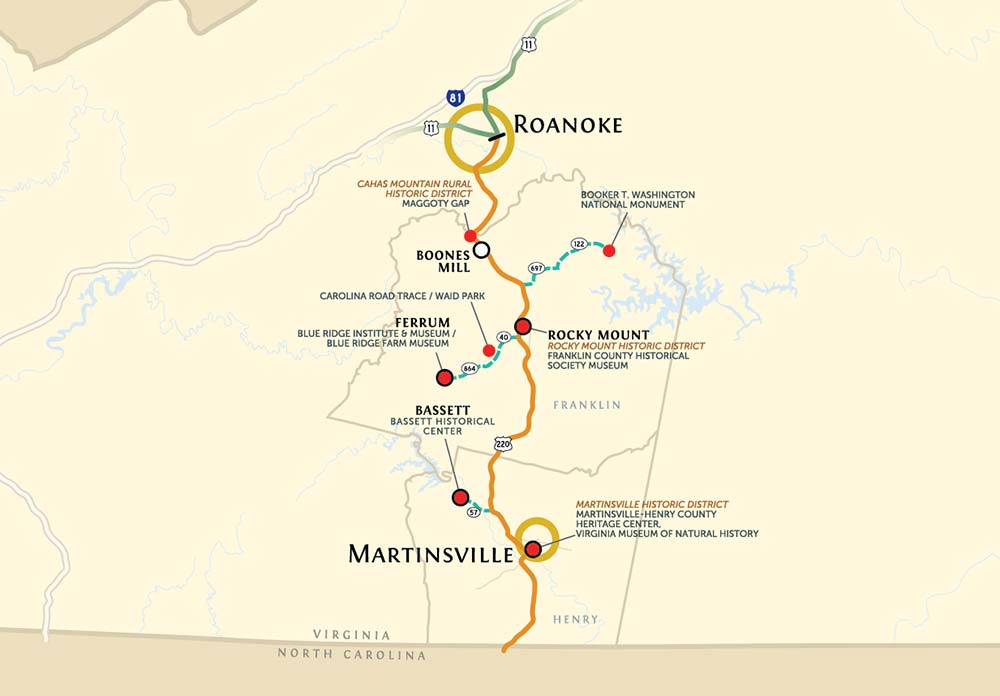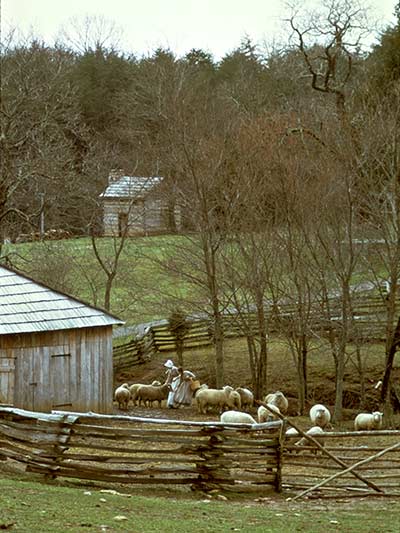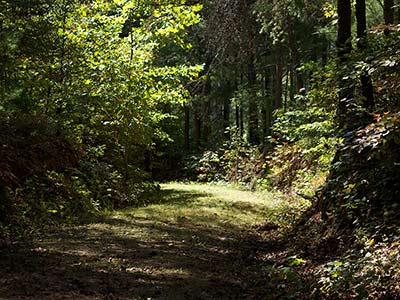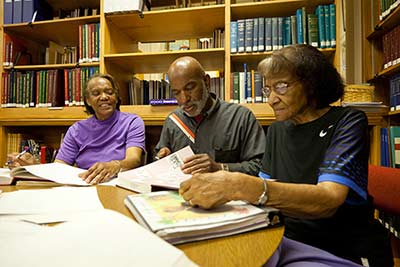Sites
Maggoty Gap
Cahas Mountain Rural Historic District, Rt. 613, Boone’s Mill, Virginia
Website
Driving Directions
The Cahas Mountain Rural Historic District comprises the bottomland along Maggodee Creek, the south side of Maggodee Gap, and the slopes of Cahas Mountain. The district includes the well-preserved trace of the Carolina Road where it crosses the Blue Ridge at Maggodee Gap. The volume of travel along the road spurred the construction of the district’s two impressive 1820s brick residences, the John and Susan Boon House and the Taylor-Price House, the former and probably also the latter provided accommodations to travelers on a commercial basis. The road trace passes in front of the Washington and Rinda Boon House.
Booker T. Washington National Monument
12130 Booker T Washington Highway, Hardy, Virginia
Website
Driving Directions
Booker T. Washington National Monument commemorates the birthplace of America’s most prominent African American educator and orator of the late nineteenth and early twentieth centuries. The property evokes an 1850s middle class tobacco farm, representative of Booker T. Washington’s childhood at the farm owned by the prosperous Burroughs family. He was born in 1856 to their enslaved cook, Jane, and lived on the farm throughout the Civil War. After the Civil War, Washington became the first principal of Tuskegee Normal and Industrial School. As an adviser, author and orator, he became the most influential African-American of his era.
Franklin County Historical Society Museum
508 Franklin Street, Rocky Mount, Virginia
Website
Driving Directions
Rocky Mount was designated as the seat of Franklin County, Virginia, when the county was formed in 1786. The first court sessions were held in the home of James Callaway, the proprietor of the 1770 Washington Iron Furnace. A log courthouse was built at the intersection of Court and Main streets in the same year. The Franklin County Historical Society operates a history museum and research library for family history research. Franklin County court, probate, and land records, also available at the nearby Franklin County Courthouse, are an important source for family historians.
Carolina Road Trace/Waid Park
700 Waid Park Road, Rocky Mount, Virginia
Website
Driving Directions
A one-quarter mile section of the roadbed of the Carolina Road can be walked in Franklin County’s Waid Recreation Park. Thousands of settlers passed this spot from the 1740s through the 1760s. The park serves recreational purposes, including hiking, bird-watching, floating and fishing in the Pigg River. It also includes a new sports complex with five soccer fields.
Blue Ridge Institute and Museum/Blue Ridge Farm Museum
Ferrum College, 20 Museum Drive, Ferrum, Virginia
Website
Driving Directions
Ferrum College opened the Blue Ridge Institute and Museum in the early 1970s to document and interpret the folk heritage of the Blue Ridge area. The museum has an important collection of furniture, textiles, and decorative arts from the region. The institute presents the annual Blue Ridge Folklife Festival, the state’s largest celebration of regional folkways, and the Blue Ridge Farm Museum, a living history farmstead demonstrating early rural life, including cooking, farming, crafts, and historic animal breeds.
Bassett Historical Center
3964 Fairystone Park Highway, Bassett, Virginia
Website
Driving Directions
The Bassett Historical Center contains an extensive collection of genealogical research and local history research for both Henry and Patrick counties and Martinsville. The Center currently houses family files, local history files, genealogy books, early African-American materials, and the histories of local industries. It is regularly open for visitors pursuing family history research.
Martinsville-Henry County Heritage Center
1 East Main Street, Martinsville, Virginia
Website
Driving Directions
Martinsville was laid out in 1791 on the land of tobacco planter George Hairston as the seat of Henry County. It was named in honor of Joseph Martin, a legendary frontiersman, Indian trader and hero of the American Revolution. The original log courthouse was replaced by a brick structure in 1824. This was remodeled in 1929 and, since 2011, houses the Martinsville-Henry County Heritage Center & Museum. The museum contains exhibits detailing the history of the town and county. The courthouse is the first stop on a walking tour of Martinsville.
Virginia Museum of Natural History
21 Starling Avenue, Martinsville, Virginia
Website
Driving Directions
The Virginia Museum of Natural History is affiliated with the Smithsonian Institution. Natural history research, exhibit collections, and educational programs at the museum provide an opportunity for better understanding of the environment that shaped early settlement, both by Europeans and Native Americans. Permanent exhibit galleries include “Uncovering Virginia and How Nature Works,” the Hahn Hall of Biodiversity, and the Fossil Overlook. One exhibit details the excavation of the important Totero Indian settlement at the Graham-White site on the Roanoke River at present-day Salem, Virginia.
